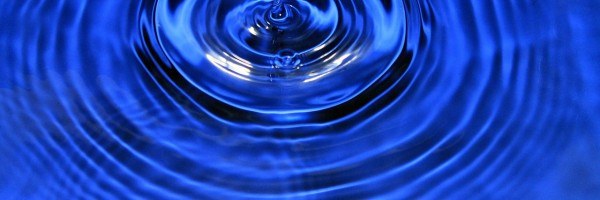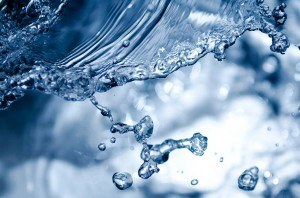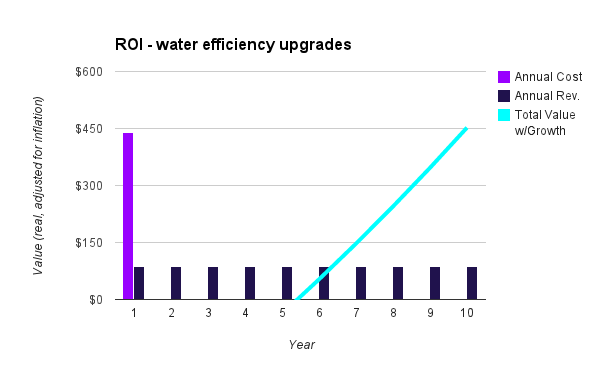
Abstract
Upgrading toilets, faucets, and shower heads in a 2-person, 2-bath home saves about $450 over 10 years. The upgrades don’t really start to pay for themselves until years 4 through 6 though.
Intro
I’m a renter by choice, but this article is for the home-owners (and landlords?) out there. It is about replacing and/or upgrading water faucets, shower heads, and toilets with newer, more efficient models, and whether or not that saves the average household a lot of money.
There are some extremely efficient water fixtures on the market today, but the standard I’ll be using is EPA’s WaterSense, which is pretty similar to the Energy Star rating for appliances, except it is for water. WaterSense fixtures might not be the most efficient ones on the market, but they are still a pretty big improvement over models built to older standards.
Before I jump into the numbers, it is worth noting that some states and/or cities provide incentives or rebates for WaterSense upgrades. You can check the list here. I’m lucky enough to live in Portland where we actually had someone from the city going door-to-door installing CFL light bulbs, high-efficiency faucet aerators, and new shower heads… for free! Cha-ching! Now if they would only start subsidizing my renewable energy bill…

The numbers
For this example, I’m assuming a 2-person, 2-bath household because those are the kind of folks I’d imagine think about this kind of thing. If you’ve got kids in the house and the same number of bathrooms, the savings go up because water use is higher while retrofit / replacement costs stay the same. Not rocket science, right?
The specific fixtures that would be replaced in this example are two toilets and two shower heads. The fixtures that would simply be upgraded are the faucets, including two in the bathrooms and one in the kitchen. The cost of those parts would look something like this:
- New toilets: $130 x 2 = $260
- New shower heads: $25 x 2 = $50
- Bathroom sink aerators: $5 x 2 = $10
- Kitchen sink swivel aerator: $10
- TOTAL for parts: $330
I’m also assuming about an hour of combined time for shopping for the toilet and installing the faucets and shower heads at a cost of $10 per hour. I’m estimating about $100 in toilet installation costs as well since I know someone who is pretty handy and still ended up with significant water damage after trying to do it themselves. Installing this yourself successfully could actually bump the ROI up quite a bit, but the downside risk is somewhat large.
Anyway, those are my assumptions. The savings expected from the various upgrades look like this and come from the EPA’s calculator:
- 2 New toilets: $68 per year
- 3 new faucets: $4 per year
- 2 new shower heads: $16 per year
- GROSS savings: $88 per year
Plugging all that into the ROI model, I get something like this:
- 10-Year NPV: $452
- 10-Year ROI: 103%
- 10-Year Payback: 5.9 years

I like this chart because it clearly illustrates the 100% return on investment. You can see that the initial investment is about $450 and you don’t start to turn a profit until year 5, where the aqua blue line first makes an appearance. However, by year 10, the total value is pretty much right in line with the initial investment. Knowing that the ROI formula is net profit divided by total investment, the ROI here is simply $450 divided by $450, or 1 (100%).
Anyway, the point is that these investments pay for themselves in a little under 6 years, maybe even less if you have more people in the house or fewer fixtures. The total dollars saved, $450, aren’t that exciting, but hey, you’re sort of helping save the planet by consuming less resources. Not to mention that the savings continue to grow past year 10, all the way until new fixtures need to be installed.

I bundled all the upgrades together because they all pay for themselves individually in about 5 years, although the shower heads are actually closer to 4. All-in-all if you plan to be in your current place for longer than 5 years, it starts to make sense to replace and/or upgrade faucets, shower heads, and toilets. If you’re not planning to be there that long or don’t know, maybe it doesn’t make sense. The good thing with the shower heads and faucet aerators, however is that you could actually bring those with you if you decide to move.
So that’s the low-down on water efficiency upgrades for the home. Bottom line: not a bad idea for the long-term home owner.